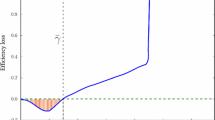Abstract
When contributors to a common cause (or public good) are uncertain about each others’ valuations, early contributors are likely to be cautious in free-riding on future contributors. Contrary to the case of complete information, when contributors have independent private valuations for the public good, the expected total contribution generated in a sequential move game may be higher than in a simultaneous move game. This is established in a conventional framework with quasi-linear utility where agents care only about the total provision of the public good (rather than individual contribution levels) and there is no non-convexity in the provision of the public good. We allow for arbitrary number of agents and fairly general distribution of types.
Similar content being viewed by others
References
Admati A, Perry M (1991) Joint projects without commitment. Rev Econ Stud 58: 259–276
Agastya M (2009) Transparency of peer activities confounds cheap talk in joint projects. University of Sydney (Economics) Working paper
Agastya M, Menezes F, Sengupta K (2007) Cheap talk, efficiency and egalitarian cost sharing in joint projects. Games Econ Behav 60: 1–19
Andreoni J (1998) Toward a theory of charitable fund-raising. J Polit Econ 106: 1186–1213
Andreoni J (2006) Philanthropy. In: Kolm S-C, Mercier Ythier J (eds) Handbook of giving, reciprocity and altruism. North Holland, Amsterdam, pp 1201–1269
Bag PK, Roy S (2008) Repeated charitable contributions under incomplete information. Econ J 118: 60–91
Bessen J, Maskin E (2009) Sequential innovation, patents and imitation. Rand J Econ 40: 611–635
Bliss C, Nalebuff B (1984) Dragon-slaying and ballroom dancing. J Public Econ 25: 1–12
Coats JC, Gronberg TJ, Grosskopf B (2009) Simultaneous versus sequential public good provision and the role of refunds—an experimental study. J Public Econ 93: 326–335
Cremer J, Riordan MH (1985) A sequential solution to the public goods problem. Econometrica 53: 77–84
Fershtman C, Nitzan S (1991) Dynamic voluntary provision of public goods. Eur Econ Rev 35: 1057–1067
Glazer A, Konrad KC (1996) A signaling explanation for charity. Am Econ Rev 86: 1019–1028
Gradstein M (1992) Time dynamics and incomplete information in the private provision of public goods. J Polit Econ 100: 581–597
Harbaugh W (1998) What do donations buy? A model of philanthropy based on prestige and warm glow. J Public Econ 67: 269–284
Jackson MO, Moulin H (1992) Implementing a public project and distributing its cost. J Econ Theory 57: 125–140
List J, Lucking-Reiley D (2002) The effects of seed money and refunds on charitable giving: Experimental evidence from a university capital campaign. J Polit Econ 110: 215–233
Marx LM, Matthews SA (2000) Dynamic voluntary contribution to a public project. Rev Econ Stud 67: 327–358
Menezes F, Monteiro PK, Temimi A (2001) Private provision of discrete public goods with incomplete information. J Math Econ 35: 493–514
Palfrey TR, Rosenthal H (1988) Private incentives in social dilemmas: the effects of incomplete information and altruism. J Public Econ 35: 309–332
Potters J, Sefton M, Vesterlund L (2005) After you—endogenous sequencing in voluntary contribution games. J Public Econ 89: 1399–1419
Romano R, Yildirim H (2001) Why charities announce donations: a positive perspective. J Public Econ 81: 423–447
Silverman WK, Robertson SJ, Middlebrook JL, Drabman RS (1984) An investigation of pledging behaviour to a national charitable telethon. Behav Ther 15: 304–311
Soetevent AR (2005) Anonymity in giving in a natural context—a field experiment in thirty churches. J Public Econ 89: 2301–2323
Varian HR (1994) Sequential contributions to public goods. J Public Econ 53: 165–186
Vega-Redondo F (1995) Public subscriptions and private contributions. Soc Choice Welfare 12: 193–212
Vesterlund L (2003) The informational value of sequential fundraising. J Public Econ 87: 627–657
Winter E (2006) Optimal incentives for sequential production processes. Rand J Econ 37: 376–390
Author information
Authors and Affiliations
Corresponding author
Rights and permissions
About this article
Cite this article
Bag, P.K., Roy, S. On sequential and simultaneous contributions under incomplete information. Int J Game Theory 40, 119–145 (2011). https://doi.org/10.1007/s00182-010-0230-1
Accepted:
Published:
Issue Date:
DOI: https://doi.org/10.1007/s00182-010-0230-1




